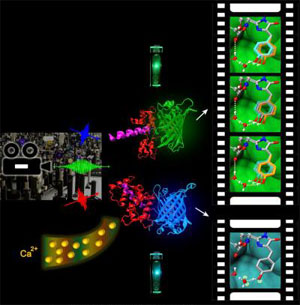A new biosensor imaging system is turning health research into a molecular movie star, as it allows scientists for the first time to view life processes at the molecular level as they are happening.
A team from Oregon State University and the University of Alberta developed the new imaging system, which could lead to the creation of more effective biosensors capable of studying in real time and on video everything from cell metabolism and nerve impulses to the body’s reaction to the flu virus and how a malignant tumor spreads.
“With this technology we’re going to be able to slow down the observation of living processes and understand the exact sequences of biochemical reactions,” said Dr. Chong Fang, an assistant professor of chemistry in the OSU College of Science who led the study.

Fluorescent protein biosensors capture the biochemical process of life in real time. Courtesy of Oregon State University.
The new approach uses femtosecond lasers and green fluorescent proteins to take measurements of chemical and biological actions. The researchers said they have been able to watch such measurements in real time and also study them frame by frame.
“We believe this is the first time ever that you can really see chemistry in action inside a biosensor,” Fang said. “This is a much more powerful tool to study, understand and tune biological processes.”
Obtaining such detailed images could also make it possible for scientists to create customized biosensors, the researchers said. Until now, biosensor systems have generally been created through trial and error processes, they said.
In the study, the researchers used femtosecond stimulated Raman spectroscopy to look at the excited state conformational dynamics of a biosensor they developed for rapid calcium ion sensing. Insight the team has acquired will “aid rational design in bioengineering to generate versatile, robust and more sensitive optical sensors,” according to the study.
The work was funded in part by the Natural Sciences and Engineering Research Council of Canada and the Canadian Institutes of Health Research. The research was published in Proceedings of the National Academy of Sciences (doi: 10.1073/pnas.1403712111).
For more information, visit www.oregonstate.edu.